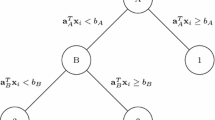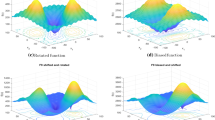Abstract
We report and analyze the results of our computational testing of branch-and-cut for the complementarity-constrained optimization problem (CCOP). Besides the MIP cuts commonly present in commercial optimization software, we used inequalities that explore complementarity constraints. To do so, we generalized two families of cuts proposed earlier by de Farias, Johnson, and Nemhauser that had never been tested computationally. Our test problems consisted of linear, binary, and general integer programs with complementarity constraints. Our results on the use of complementarity cuts within a major commercial optimization solver show that they are of critical importance to tackling difficult CCOP instances, typically reducing the computational time required to solve them tremendously.


Similar content being viewed by others
References
Balas, E.: Facets of the knapsack polytope. Math. Progr. 8, 146–164 (1975)
Beale, E.M.L., Tomlin, J.A.: Special facilities in a general mathematical programming system for nonconvex problems using ordered sets of variables. In: Lawrence, J. (ed.) Proceedings of the Fifth International Conference on Operations Research, pp. 447–454. Tavistock Publications, London (1970)
Bean, J., Noon, C., Ryan, S., Salton, G.: Selecting tenants in a shopping mall. Interfaces 18, 1–9 (1988)
Cottle, R.W., Pang, J.S., Stone, R.E.: The Linear Complementarity Problem. Academic Press, New York (1992)
Crowder, H., Johnson, E.L., Padberg, M.: Solving large-scale zero-one linear programming problems. Oper. Res. 31, 803–834 (1983)
Danna, E.: Solving optimization problems at google. Talk presented at the 2010 INFORMS national meeting, Austin (2010)
Dantzig, G.B.: On the significance of solving linear programming problems with some integer variables. Econometrica 28, 30–44 (1960)
de Farias, JR, I.R., Johnson, E.L., Nemhauser, G.L.: Facets of the complementarity Knapsack polytope. Math. Oper. Res. 27, 210–226 (2002)
de Farias, JR, I.R., Kozyreff, E., Gupta, R., Zhao, R.: Branch-and-cut for separable piecewise linear optimization and intersection with semi-continuous constraints. Math. Progr. C 5(1), 75–112 (2013)
Dowsland, K.: Nurse scheduling with tabu search and strategic oscillation. Eur. J. Oper. Res. 106, 393–407 (1998)
Gu, Z., Nemhauser, G.L., Savelsbergh, M.W.P.: Cover inequalities for 0–1 linear programs: computation. INFORMS J. Comput. 10, 427–437 (1998)
Hammer, P.L., Johnson, E.L., Peled, U.N.: Facets of regular 0–1 polytopes. Math. Progr. 8, 179–206 (1975)
Ibaraki, T.: Complementary convex programming. J. Oper. Res. Soc. Japan 15, 138–160 (1972)
Ibaraki, T.: The use of cuts in complementarity programming. Oper. Res. 21, 353–359 (1973)
Ibaraki, T., Hasegawa, T., Teranaka, J., Iwasa, K.: The multiple-choice knapsack problem. J. Oper. Res. Soc. Japan 21, 59–93 (1978)
Jeroslow, R.G.: Cutting planes for complementarity constraints. SIAM J. Control Optim. 16, 56–62 (1978)
Meyer, R.R.: Integer and mixed-integer programming models: general properties. J. Optim. Theory Appl. 16, 191–206 (1975)
Meyer, R.R.: Mixed-integer minimization models for piecewise-linear functions of a single variable. Discrete Math. 16, 163–171 (1976)
Mitchell, J.E., Pang, J.S., Yu, B.: Obtaining tighter relaxations of mathematical programs with complementarity constraints. J. Glob. Optim. (in press)
Nemhauser, G.L., Wolsey, L.A.: Integer and Combinatorial Optimization. Wiley, New York (1988)
Nguyen, T.T., Tawarmalani, M., Richard, J.P.P.: Convexification techniques for linear complementarity constraints. In: Günlük, O., Woeginger, G.J. (eds.) Integer Programming and Combinatorial (IPCO), Lecture Notes in Computer Science, vol. 6655, pp. 336–348. Springer, Berlin (2011)
Sherali, H.D., Adams, W.P.: A hierarchy of relaxations between the continuous and convex hull representations for zero-one programming problems. SIAM J. Discrete Math. 3, 411–430 (1990)
Vielma, J.P., Ahmed, S., Nemhauser, G.L.: Mixed-integer models for nonseparable piecewise linear optimization: unifying framework and extensions. Oper. Res. 58, 303–315 (2010)
Vielma, J.P., Nemhauser, G.L.: Modeling disjunctive constraints with a logarithmic number of binary variables and constraints. Math. Progr. 128, 49–72 (2011)
Williams, H.P.: Model Building in Mathematical Programming, 4th edn. Wiley, New York (1999)
Wolsey, L.A.: Faces for a linear inequality in 0–1 variables. Math. Progr. 8, 165–178 (1975)
Zhao, M., de Farias, I.R.: Branch-and-cut for separable piecewise linear optimization: new inequalities and intersection with semi-continuous constraints. Math. Progr. A 141(1–2), 217–255 (2013)
Acknowledgments
The authors acknowledge the High Performance Computing Center at Texas Tech University at Lubbock for providing resources that have contributed to the research results reported within this paper. URL: http://www.hpcc.ttu.edu. This research was partially supported by the Office of Naval Research (ONR) through grants N000140910332 and N000141310041. ONR’s support is gratefully acknowledged.
Author information
Authors and Affiliations
Corresponding author
Rights and permissions
About this article
Cite this article
de Farias, I.R., Kozyreff, E. & Zhao, M. Branch-and-cut for complementarity-constrained optimization. Math. Prog. Comp. 6, 365–403 (2014). https://doi.org/10.1007/s12532-014-0070-2
Received:
Accepted:
Published:
Issue Date:
DOI: https://doi.org/10.1007/s12532-014-0070-2
Keywords
- Complementarity
- Multiple-choice
- Special ordered set
- Mixed-integer programming
- Knapsack set
- Polyhedral method
- Branch-and-cut




